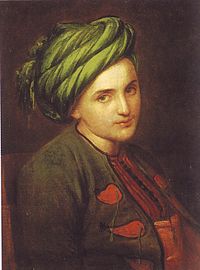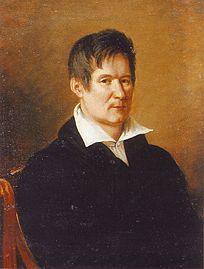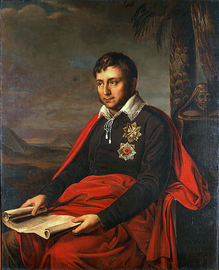
Ilya Yefimovich Repin was a Ukrainian-born Russian painter. He became one of the most renowned artists in Russia in the 19th century. His major works include Barge Haulers on the Volga (1873), Religious Procession in Kursk Province (1880–1883), Ivan the Terrible and His Son Ivan (1885); and Reply of the Zaporozhian Cossacks (1880–1891). He is also known for the revealing portraits he made of the leading literary and artistic figures of his time, including Mikhail Glinka, Modest Mussorgsky, Pavel Tretyakov, Pantaleon Szyndler, and especially Leo Tolstoy, with whom he had a long friendship.

Karl Pavlovich Bryullov, original name Charles Bruleau, also transliterated Briullov and Briuloff, and referred to by his friends as "Karl the Great", was a Russian painter. He is regarded as a key figure in transition from the Russian neoclassicism to romanticism.

Sir William Allan was a distinguished Scottish historical painter known for his scenes of Russian life. He became president of the Royal Scottish Academy and was made a Royal Academician.
Events in the year 1826 in Art.

George Dawe was an English portraitist who painted 329 portraits of Russian generals active during Napoleon's invasion of Russia for the Military Gallery of the Winter Palace. He relocated to Saint Petersburg in 1819, where he won acclaim for his work from the artistic establishment and complimentary verses by Pushkin. He was the son of Philip Dawe, a successful mezzotint engraver who also produced political cartoons relating to the events of the Boston Tea Party. One of his brothers was Henry Edward Dawe, also a portraitist. He died on 15 October 1829 in Kentish Town, United Kingdom.

Alexey Vasilievich Tyranov was a Russian portrait and genre painter.

Alexey Gavrilovich Venetsianov was a Russian painter, renowned for his paintings devoted to peasant life and ordinary people.

Grand Duchess Maria Nikolaievna of Russia was a daughter of Emperor Nicholas I of Russia, and sister of Alexander II. In 1839 she married Maximilian, Duke of Leuchtenberg. She was an art collector and President of the Imperial Academy of Arts in Saint Petersburg.
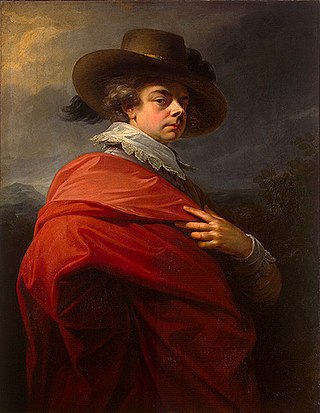
Prince Nikolai Borisovich Yusupov was a Russian nobleman and art collector of the House of Yusupov.

Alexander Ivanovich Savinov was a Russian and Soviet painter and art educator who lived and worked in Saint Petersburg (Leningrad). He was a member of the Leningrad Union of Artists, regarded as one of the founders of the Leningrad School of painting.

Emíl Wíesel – a painter, museum curator and a board member of the Imperial Academy of Arts, Russia, organizer of international art exhibitions, councilor of Hermitage and Russian museum and Legion of Honor holder. During soviet times he was an expert in Russian and Western fine arts and sculpture in the Glavnauka museum department.

Alexey Nikolayevich Olenin was a Russian archaeologist, most notable for being a director of the Imperial Public Library between 1811 and 1843 and the sixth president of the Imperial Academy of Arts between 1817 and 1843.

The Walpole collection was a collection of paintings and other works of art at Houghton Hall in Norfolk and at other residences of Sir Robert Walpole. Many of the important works were sold in 1779 to Catherine the Great of Russia, and the Hermitage Museum still owns more than 120 works from the collection.

Fedor Grigoryevich Solntsev was a Russian painter and historian of art. His artwork was a major contribution in recording and preserving medieval Russian culture, which was a common subject of his paintings. He was the main author of the fundamental work Antiquities of the Russian State, the main decorator of interiors of the Grand Kremlin Palace in Moscow. He discovered and restored mosaics and frescoes of Saint Sophia Cathedral, Kyiv and Cathedral of the Dormition of Kyiv Pechersk Lavra in Kyiv, and of Cathedral of Saint Demetrius in Vladimir.
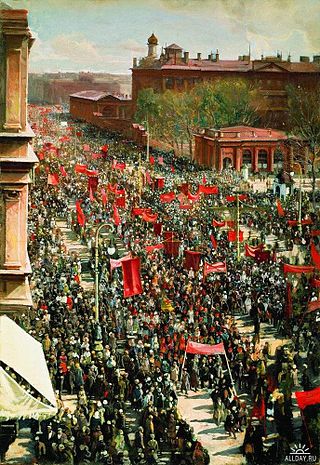
The fine art of Leningrad is an important component of Russian Soviet art—in the opinion of the art historians Vladimir Gusev and Vladimir Leniashin, "one of its most powerful currents". This widely used term embraces the creative lives and the achievements of several generations of Leningrad painters, sculptors, graphic artists and creators of decorative and applied art from 1917 to the early 1990s.

Anton Mikhailovich Legashov, also Legashev or Legashyov was a Russian landscape and portrait painter.

Mikhail Tikhonovich Tikhanov was a Russian artist who accompanied Captain Vasily Golovnin's circumnavigation aboard the frigate Kamchatka.

The Poltoratsky family was a Russian noble family, descended from the Cossack Mark Fedorovich Poltoratsky (1729–1795), who during the reign of Catherine the Great, was in charge of the Court Singing Chapel. The Poltoratsky coat of arms shows a harp as a sign of this.

The Last Supper is a painting by the Russian painter Nikolai Ge (1831-1894), completed in 1863. It is part of the collection of the State Russian Museum in Saint Petersburg. The size of the picture is 283 × 382 cm.

Alexander Vasilievich Polyakov was a Russian portrait painter.

